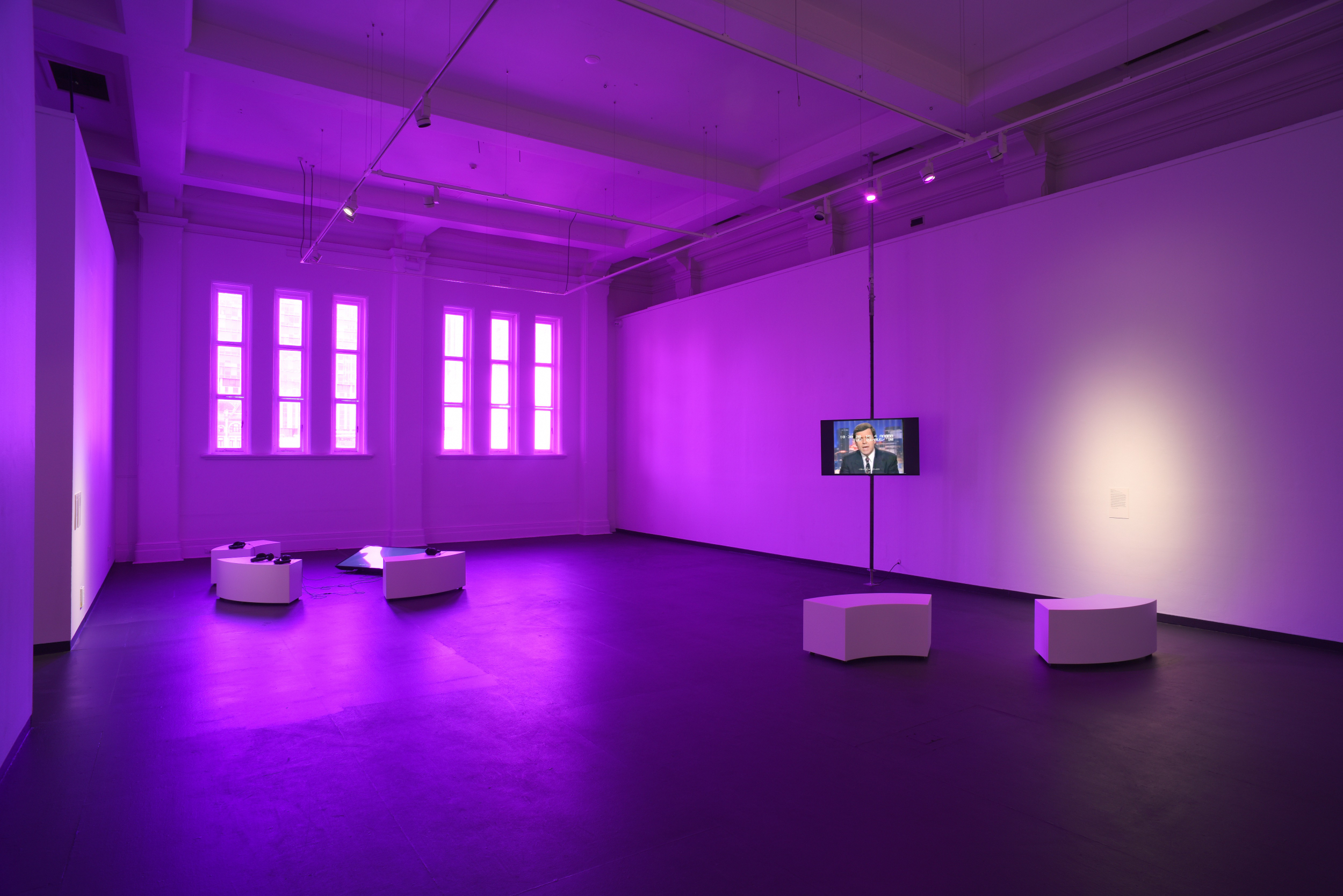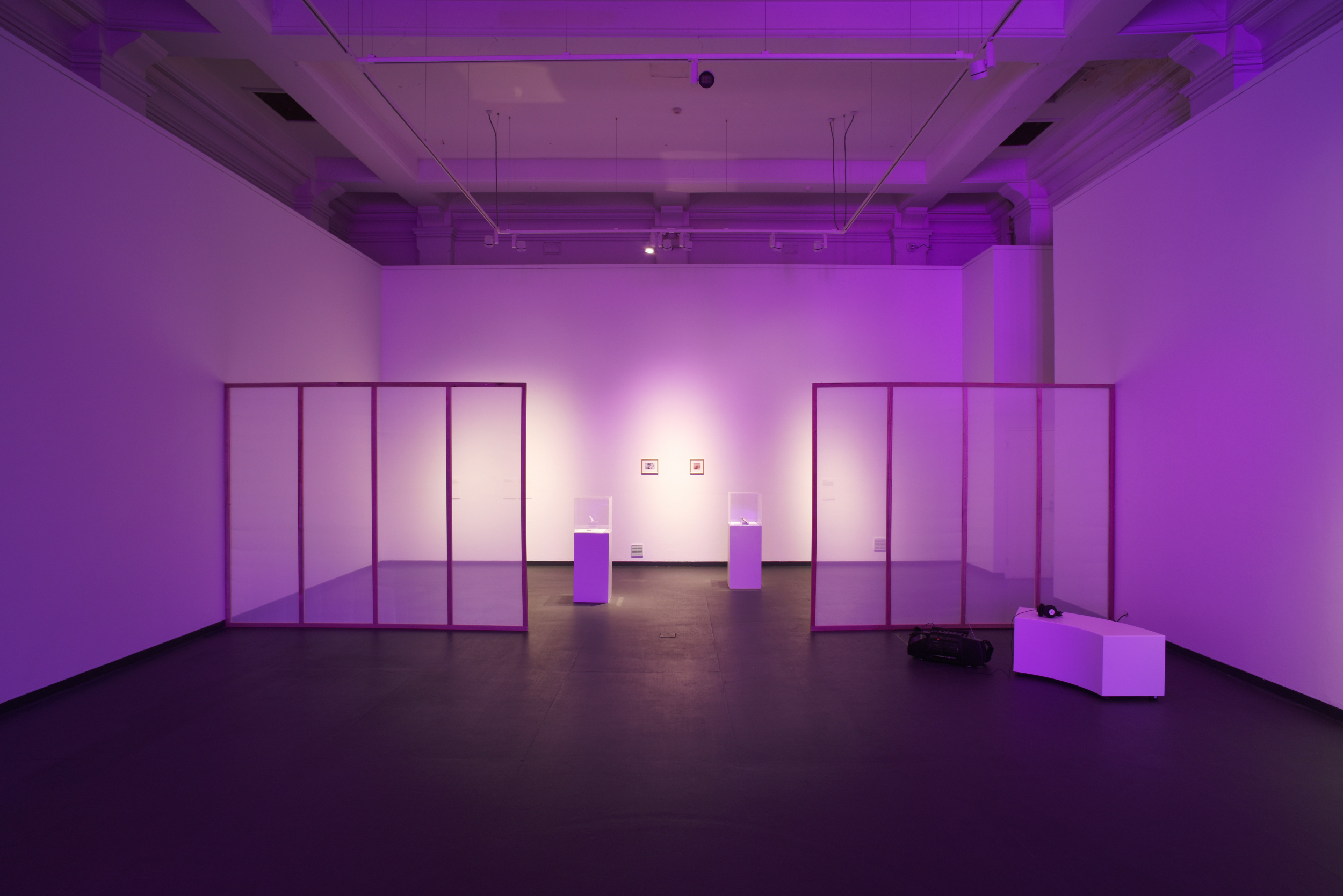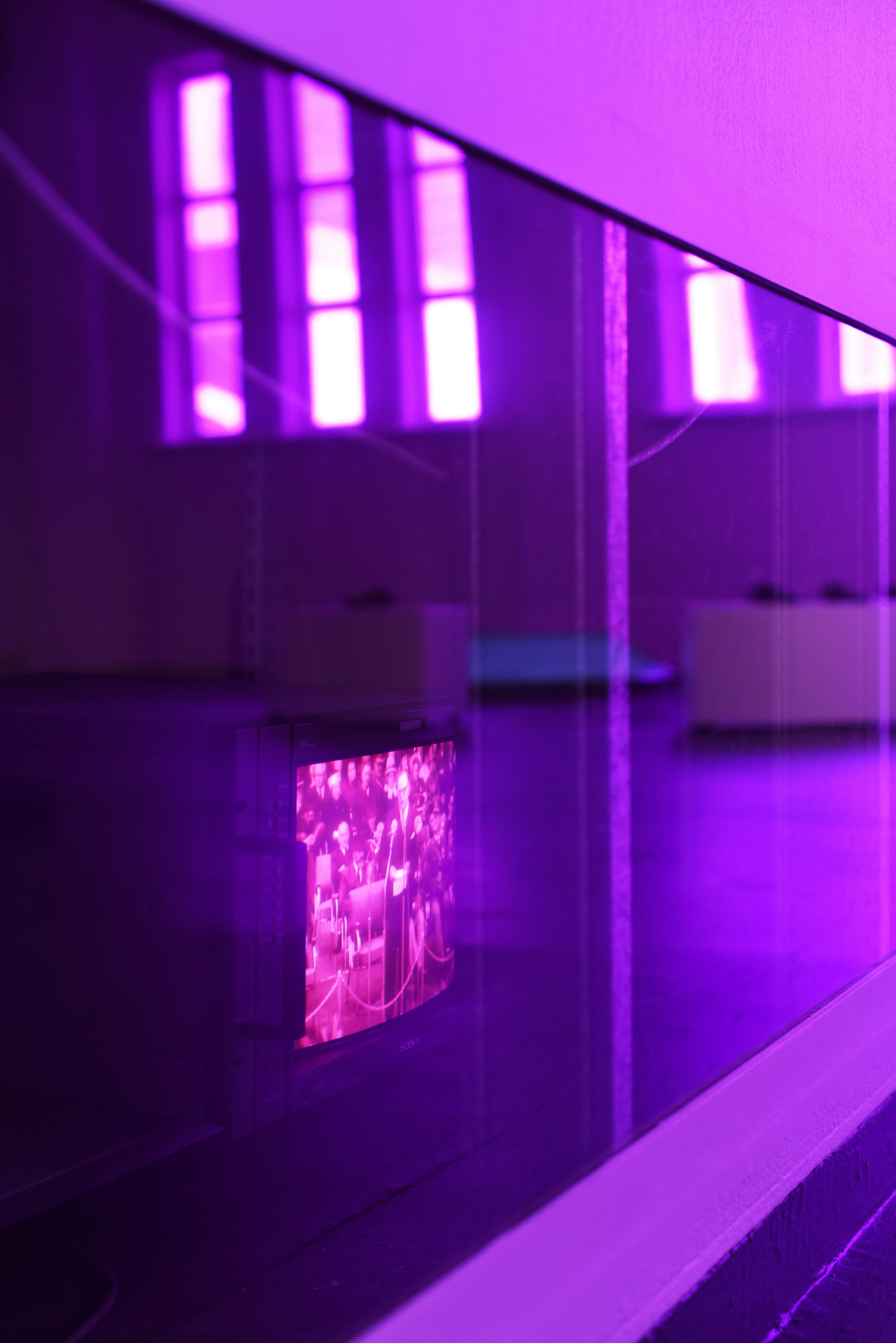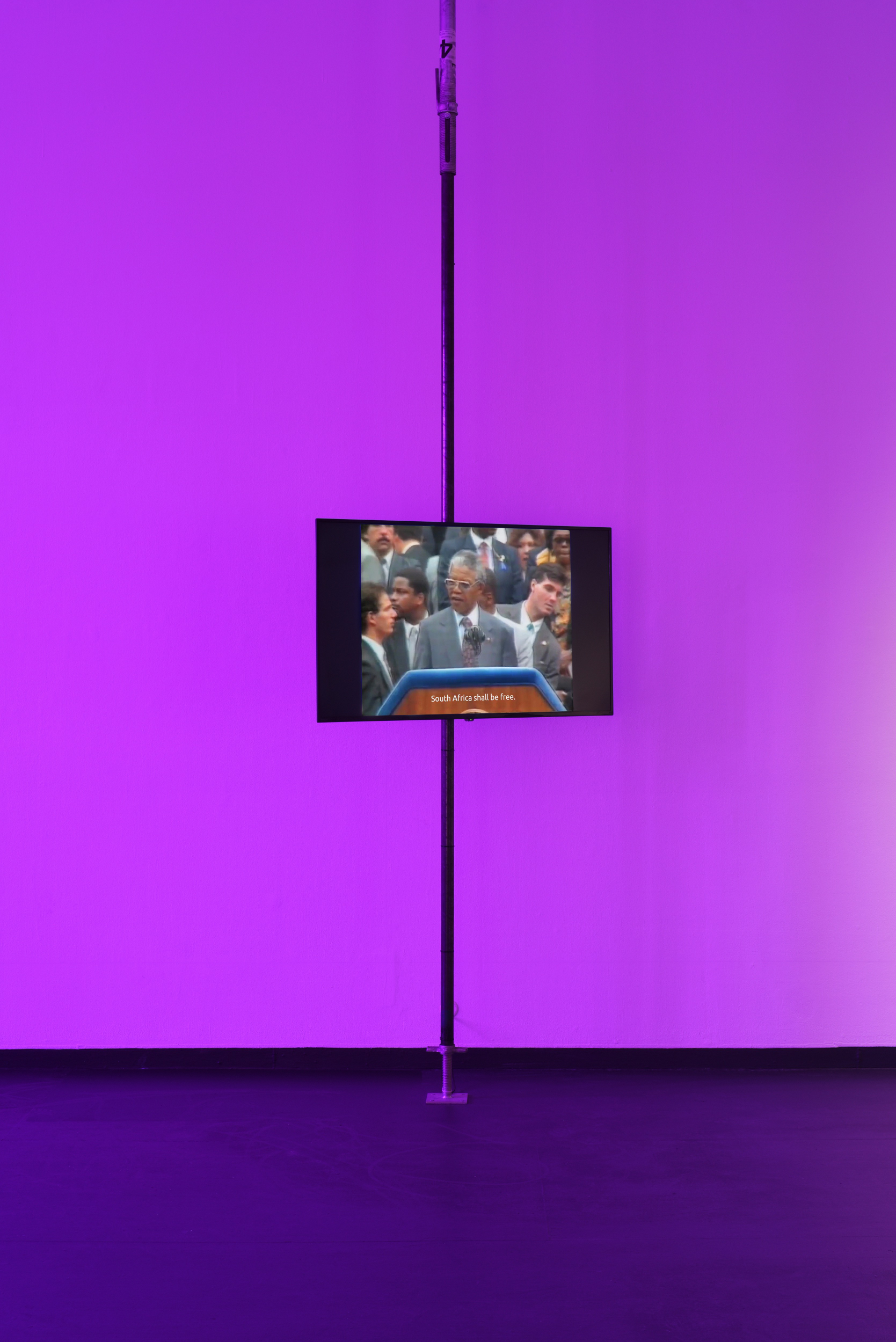Roberta Joy Rich, The Purple Shall Govern, Perth Institute of Contemporary Arts, 03 November - 31 December 2023
I enter through the PICA Hub (Activity Space). Painted purple, the room heaves with the collective grief that has amassed in the six weeks since the exhibition's opening. “Free Gaza” is etched in chalk provided by the artist, among the searing acknowledgements that we exist on sovereign Noongar Boodjar (Aboriginal land). Roberta Joy Rich’s offering invites the viewer to share messages on the wall, disrupting the formalities of an art space through participation. A vital gesture in a heightened moment of global activism, where thousands continue to attend weekly rallies for Palestine since the Israeli military launched intensive targets in the Gaza Strip on October 7.
Beyond the gravitas that the offering takes on at this moment, the repositioning echoes other archival exhibitions examining Afro Black diaspora to this continent such as Samira Farah’s 2021 collaboration with Patrick Jonathon and Guled Abdulwasi 13 Years which exhibited at West Space (Melbourne). In a radio interview Farah explained that ‘I'm really interested in how we make spaces feel like they belong to people rather than making it feel like it belongs to the curator.’ As an artist Rich embodies these values in her own practice, which like Farah, uses archival materials connected to South Africa’s apartheid era and enduring community activism.
While Farah looks at the legacy of African community radio stations in Sydney and Canberra campaigning against South Africa’s apartheid, Rich’s work is centred on South African uprisings in Cape Town and the gruelling similarities to colonisation and racial segregation in this continent. Both create a dynamic interplay between material and audience asking that we actively engage with what is presented; rather than pushing an educative narrative, which cleanses the complexity of history and valorises political leaders like Nelson Mandela into one-dimensional heroes.
In 13 Years Farah intentionally changed the archival material featured in the exhibition regularly, shifting the photos, posters, and audio content accumulated from Patrick Jonathon’s lengthy involvement in community organising and radio programs like Skid Row. This decision was purposely employed to highlight the intrinsic problem of selection and how including or excluding material is never neutral. Instead, the viewer is encouraged to return, engage with new material that is added and accept that there is never one view, but multiple which is often obscured through government or institutional archiving of historical events.


Conceptually, this curatorial reframing is also utilised in The Purple Shall Govern. While personal, media and public archives are fixed in the gallery space the viewer is consistently invited to interpret the material in multiple ways aided through participatory elements such as a reading room called a reflective space. The area provides books, articles and a playlist which invites respite and deeper contemplation with the extensive documentation of racist regimes throughout the exhibition. This supports the viewer to form their own perspective and layered understanding of South Africa’s apartheid era and the similarities with racial policies in this continent. It also strengthens the overall exhibition by avoiding a didactical celebration of events such as the anti-apartheid Purple Rain protest in Cape Town in 1989. Where police water cannons filled with purple dye were used to mark protesters to assist with their arrests. But were later overturned by the protesters themselves, who instead sprayed the surrounding buildings in purple.
Rich respectfully captures the momentum that such an event carries within community activism, used to maintain hope against enduring oppression, but she resists suggesting that this one event did or even can resolve racial segregation. Purple is splashed across the entrance of PICA and the windows in the West End Gallery are coated with a purple glaze which permeates the space. This imbues the building with the energy of protest that movingly reflects the current gathering of bodies that take to the streets filling urban environments with colour: this time, watermelon.1 While optimistic, it does not conclude that protest movements successfully resolve social injustices but reflects humanities ongoing desire to fight for change despite the risk, failures, and limitations. Critical works in the exhibition purposely integrate historical events associated with South Africa’s apartheid, rather than idealising community incursions. An antagonisation that goes further, by examining the messiness inherent in exhibiting radical work within an institutional space.

In Though buried, They echo, Rich plays with the tensions and ironies of condemning racist rhetoric within a colonial and therefore historically racist building - PICA. Infrastructure weighted by its western architectural heritage and past use as the Perth Boys’ and Girls’ School, known collectively as Perth Central School, operating between 1877 and 1914, an intrinsic part of wider governmental systems that upheld colonial values. She appears astutely aware that artists work within these dualities and must negotiate the desire to create anti-racist work within traditionally racist or colonial institutions. The work confronts this paradigm by revealing the colonial artifice of the space rather than hiding it. A small TV plays racist speeches by Australian and South African politicians from the 1940’s to the 1960’s such as Queensland Premier ‘Joh’ Bijelke-Peterson and South African Prime Minister Hendrick Verwoed. They are played in silence, stripping their power and agency. The TV is cut into the gallery wall exposing the building's structure as if to literally and metaphorically acknowledge that while this work silences racists, it does so in a colonial structure that is also accountable: An accountability that isn’t reduced by assuming that its contemporary incarnation as an art gallery nullifies the building's past. This confronts the challenge of working within institutions who often crave a palatable or positive approach to art that engages with racial injustice, as if to mask their own role in colonisation.
Rich’s incisive gaze most significantly avoids framing the end of apartheid and Nelson Mandela’s leadership as resolutely improving people’s lives. Instead, a sense of uneasiness permeates the exhibition and draws us to the realities of contemporary racism that people continue to experience. In some ways this is most explicitly evident in the list of Support Services available in the reflective space. Its inclusion shows that Rich is painfully aware that racial segregation didn’t stop after apartheid but is ongoing. The list shows care towards the many visitors who may be triggered by the exhibition, due to the everyday racism they live though contemporaneously.

Artistically her refusal to sanitise history or heroize Mandela is decisively conveyed in the work Pigs might fly too (2022). The video reframes the voices heard during media broadcasts during Mandela’s visit to Australia in 1990 calling for an end to apartheid. Significantly only Bla(c)k voices are heard which enable a critical reflection of this era and avoids the whitewashed tendency to appoint Mandela as a saviour to all Bla(c)k peoples. Instead Trawlwoolway activist and lawyer Michael Mansell is shown at a media conference criticising the African National Congress (ANC) for their failure to acknowledge the rights of First Nations people globally and ‘prostituting themselves’ and values to gain mainstream power and political agency. Although a recent review of this work described the video as a ‘contradiction left disappointingly open’ this interpretation ignores how it exposes the splintered opinions towards Mandela. A feeling which Rich does not hide.
If anything, her decision to include this alongside footage of Gary Foley enables viewers particularly those who are Bla(c)k to engage with the hypocrisies and divisive feelings associated with Mandela’s legacy. If the video work felt ‘open’ or unresolved this was arguably intentional, another purposeful choice akin to Samira Farah’s curation of 13 Years where the artist or curator refuses to deliver clear narratives but creates offerings — in Rich’s exhibition, a reflective space — which invites deeper contemplation with the archives presented. The viewer is encouraged to read texts in the space such as Solidarity in Resistance which states ‘to what extent has post-Apartheid South Africa and especially its global icon Nelson Mandela, honoured the support of others and acted from a position of solidarity around Indigenous rights in Australia? This offering elevates Pigs might fly too demonstrating how an exhibition can present archival footage in ways that invites interpretation. The combination of art alongside a library avoids the tunnel vision that history is often presented through, revealing the contentious elements of Mandela’s leadership through the range of literature provided.
The footage in Pigs might fly too is also used to acknowledge class divisions within Bla(c)k communities where those with class privilege such as Mandela often absorbed mainstream politics to gain power which failed to address the ongoing oppression of the working class and Bla(c)k poor. Foley and Mansell’s voices speak for Bla(c)k people who have and continue to be overlooked by Bla(c)k leaders with wealth or class privilege. A vital yet often obscured issue that Rich openly and honestly confronts. In Where we stand: Class matters bell hooks proclaimed that:
‘Radical Black voices, especially those with some degree of class privilege, must have the courage to talk about class. Racial solidarity in anti-racist struggle can, sometimes does, and must coexist with a recognition of the importance of ending class elitism.’
Rich’s complex examination of archival footage connected to South Africa and so-called Australia is an example of this. Holistically, her solo exhibition is reflective of the radical voices who have the courage to talk about history in ways that reveal uncomfortable dimensions. Truths that are essential in the ongoing struggle against racism, genocide, and class privilege globally.
Timmah Ball is a writer, editor, and zine maker of Ballardong Noongar heritage. In 2021 she published the chapbook Do Planners Dream of Electric Trees? through Glom Press/ Arts House and has featured in a range of anthologies such as This All Come Back Now UQP and Best of Australian Poems 2022 Australian Poetry.
1. The image of streets filled with the colour of watermelon references the wave of rallies that have re-shaped the CBD and areas close to PICA such as Forrest Chase as people carry Palestinian flags, banners, and other markers. For further images please see Friend of Palestine Western Australia: https://fopwa.org/
References:
Samira Farah and Marissa Johnpillai, The Glasshouse, 2021 https://www.rrr.org.au/explore/podcasts/the-glasshouse/episodes/5087-samira-farah-and-marissa-johnpillai
bell hooks, Where we stand: Class matters, Routledge, New York, 2000
Dr Zayd Minty. The Purple Shall Govern: Solidarity in Resistance, ACCA, 2021-2022
Max Vickery, What We Memorialise, Dispatch Review, 2023
